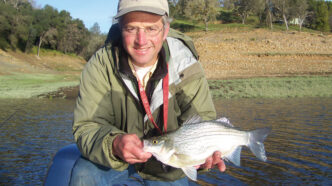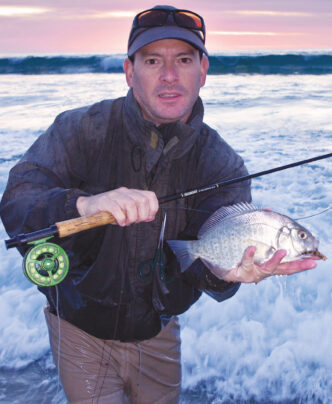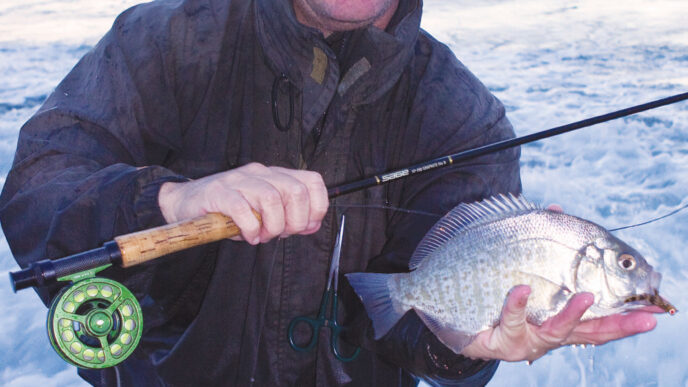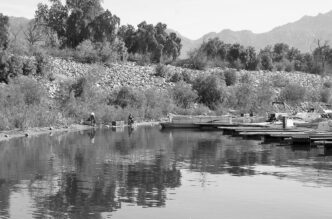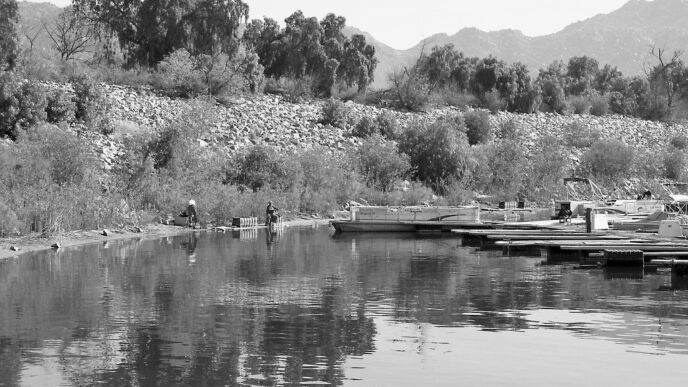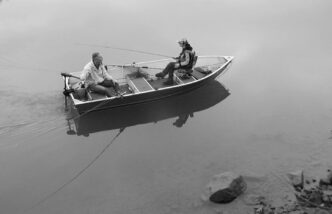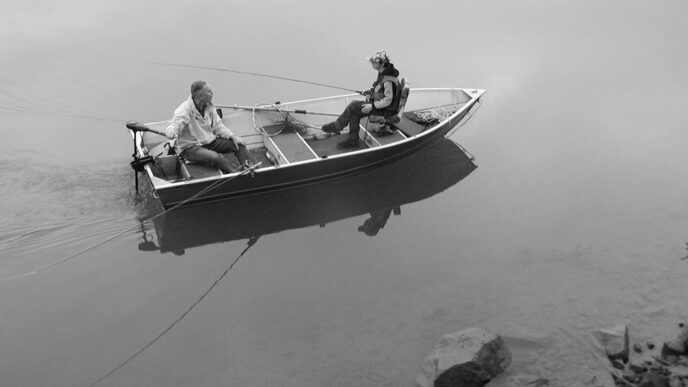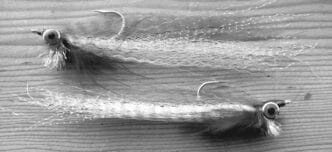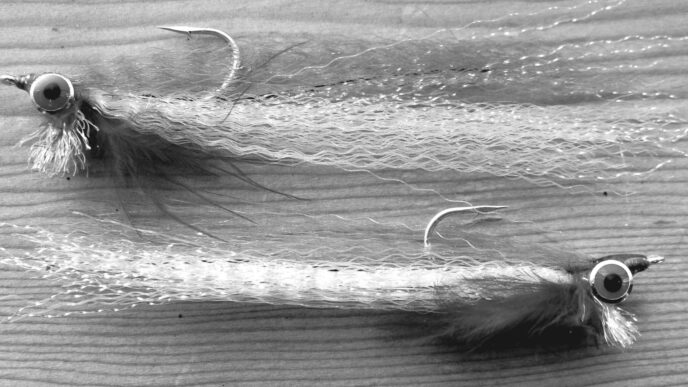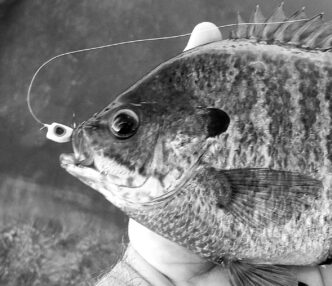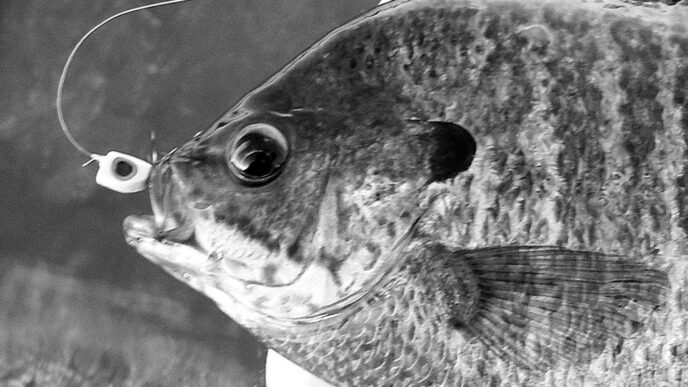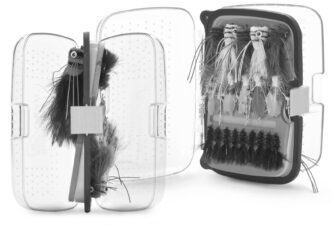As Dave Sellers throttled his boat down and we approached our chosen shoreline, we began false casting in anticipation of that first grab of the morning. It was just past 7:00 A.M., March 16, 2009, and it was our first fishing outing together for the year. My son Vern had done very well at this location just a few days prior, so our hopes were high. White bass were our targeted fish, and either whites or crappies are usually my first fish to pursue each spring. Sure, I’m still trying for steelhead at this time of year, but I consider them a fish of winter past.
We had been casting our flies tight to the shoreline and stripping them back to the boat for about 10 minutes when I missed a strike, then, almost immediately after my missed hit, Dave hooked and landed a white. We methodically worked this stretch of shoreline for about 30 minutes and between us picked up another five or six fish — action, yes, but not the type of bite we hoped for, so we moved on.
For the next three hours, we found the occasional willing biters, but not the kind of continued bite for which we hungered. We even motored up to the Nacimiento River, just to see if large numbers of fish were spawning. We saw only a few white bass in the crystal-clear waters of the river, so it was back to exploring the Narrows and the stretch just outside the five-mile-per-hour buoy.
By late morning, we had found the concentrations of whites we were seeking. Once we had figured out the type of shoreline where the bass seemed to be holding this day, which was shady areas with lots of rubble, we were into them almost constantly throughout the day and into the evening. One or the other of us seemed to be hooked up all the time, with numerous doubles. We were laughing and cracking up at each other’s antics, and we marveled when groups of whites would follow our hooked fish back toward the boat. Simply, it was the kind of banner day that any of us might wish for.
When a bite would cease, often we had to move only a short distance to find another willing group of whites. I won’t tell you how many fish we caught, but as Dave told a lure angler in the parking lot as we prepared to leave, “You wouldn’t believe the numbers.”
Action like this is repeated over and over during the spring and early summer at Lake Nacimiento — not that every outing will be a 50-to-100-fish day, but those numbers and higher can occur at any time, given the right concentrations of fish.
White bass and fly fishing just seem to have been made for each other, because whites are voracious feeders and most often willingly strike any small streamer retrieved near them. Their primary food source is threadfin shad, and two-to-four-inch streamers will usually catch their attention and evoke a positive reaction.
If you’ve fished for stripers, you know how to fish for white bass, because many of their characteristics are the same. They are schooling fish, primarily minnow feeders, love structure as well as open water, and will eat surface lures and sunken flies equally well. Just scale down the tackle for a fish of one to three pounds.
If you think one-to-three-pound fish won’t give much of a fight, just hook them on 4-weight to 6-weight rods and have your eyes opened. I know fly fishers who use 7-weight and 8-weight rods for white bass, just so they can control and land them more quickly and thereby get their fly back to the action a little faster. These gamesters can pull!
Lake Nacimiento
At the turn of the twentieth century, white bass were thought to exist only in the Great Lakes and the tributaries of the Mississippi River, but since then, they have been introduced into many waters of the Southwest and West, including Lake Nacimiento in Monterey County. White bass seem to prefer large reservoirs that have running streams and rivers entering them in the spring, which white bass need to spawn successfully.
White bass had a humble beginning at Nacimiento. In 1965, the California Department of Fish and Game planted a meager 160 juvenile white bass, then followed up in 1966 with 64 adult whites. For all the thousands the lake now has, it started with just those two small introductory plants. What a success story!
Nacimiento has two main spawning waterways. They are the Nacimiento River and Las Tablas Creek. There are numerous other smaller streams that feed the reservoir, but even in very wet years, they provide only a trickle of water. However, at times, white bass will congregate near where the small feeder streams enter the lake, so exploratory casts in the vicinity of these waters are always worthwhile.
Most fly fishers target white bass in March and April, when the fish can be found either in the flowing waters, spawning, or traversing to and from spawning areas. Dave and I encountered traveling fish within one to three miles of Nacimiento River and also observed fish spawning within a mile of the river. However, postspawn fish can be just as exciting, because they remain in large schools and offer opportunities for surface action that the prespawn fish usually do not.
As a result, in my opinion, there actually is a four-month window in which fly fishers should concentrate their efforts when targeting white bass: March, April, May, and June. Depending on weather conditions, you could tighten that time period by saying the optimum time is from the middle of March to the middle of June. Early March can be iffy, with threats of rain and muddy waters, and once you get into mid-June, daytime temperatures can become oppressive.
If pursuing spawning fish, figure that most years the spawn will be completed by the middle of April, depending somewhat on whether it was a cold, wet year, or a dry, warm one. In years of little rain and warming water temperatures, the spawn could be over by the end of March. In cool, wet years, I’ve witnessed active spawning into the last week of April.
When squadrons of whites are either going to or coming from their spring fling, fly fishers should concentrate their efforts inside the five-mile-per-hour buoys of the Las Tablas arm and the Nacimiento arm of Lake Nacimiento. Once inside these zones, the waterways narrow considerably, and it becomes easier to locate fish.
If most of the white bass are actively spawning, the places to fish are the river on the Nacimiento arm and the area directly downstream from the waterfall where Las Tablas Creek dumps into the lake. However, whites don’t hang around once they have completed their spawning duties. One day, the flowing water will be jammed with fish, and the next day, few, if any, will be there. Then, one or two days later, the moving water will fill up with fish again. I’ve seen the river barren of fish in the morning, yet packed with fish by evening. Spawning whites are unpredictable, but a delight when you hit them right.
If the moving waters don’t contain large numbers of fish, don’t waste your time there. Fish the narrow sections of the lake through which you have just passed. You could encounter groups of whites staging to spawn or run into them as they travel back into the lake proper. Either way, the action can be fast and furious, once you locate a pod of whites.
I well remember a Sunday afternoon a few years ago. I was fishing with my son Vern and we had heard that the white bass were spawning in the Las Tablas arm. We began our fishing day casting flies in the flowing water below where the creek falls into the lake, but caught only a few fish.
We then fished different spots in the Las Tablas arm over the next few hours, but again found few fish for our efforts. That was until about midday, when we got a series of double hookups along a nondescript shoreline with a small cove. There were so many whites concentrated in this tight area that I finally dropped anchor, because there was no need to keep controlling the drift of the boat.
We were each fishing two-fly rigs that day, and although I don’t remember the total number caught between us, I do recall that Vern landed eight double hookups and I boated seven doubles.
I cite this example only to stress that you should keep searching the narrow channels of the two spawning waters during the time of year when the whites are doing their mating. Somewhere within these confined waters, there should be decent numbers of fish. It’s up to you to keep exploring until you find them.
Post-Spawn Angling
For a different twist on fishing whites, but with possibly similar fast action, try fishing for them after their spawning rigors are completed and they are ravenously pursuing the vast schools of threadfin shad that inhabit Nacimiento Lake. Whites create havoc and mayhem on the defenseless shad, often pushing them to the surface or cornering them along a shoreline, where shad often can be seen flopping on dry land to escape their predators. The postspawn period is the time to fish poppers the same size and color as the streamers used for spawning whites.
I’ll never forget one spring day when Dan Blanton and I were chasing whites at Nacimiento. We saw a crow fly by with a flopping shad in its beak, then right behind it another crow with a shad. Wondering how the crows had caught the shad, we rounded a point, and before us was a small bay alive with panicked shad, splashing and jumping out of the water with busting white bass everywhere among them. There were also flopping shad all over the shoreline as they tried to evade being eaten, and walking among them were crows — our wondering about their fishing ability was answered. Since that time, I have seen other crows with shad, and I immediately start exploring in the direction from which I saw them flying, knowing that somewhere, shad are encountering predators on the shore, as well as in the water.
I’ve found that to encounter prolonged surface action for white bass, the best time to be on the lake is at first light and a couple of hours after, before the water-skiers get active and keep the lake churning. The surface action often continues with the choppy water, but it becomes much more difficult to spot whites busting shad on the surface unless you are nearby.
I rely a lot on my fish finder when fishing for whites in the late spring, looking for schools of bait to show on the screen. Once my meter shows plenty of bait, I figure there should be white bass nearby. My attention really perks up when the bait schools are mostly small and at scattered depths, because that usually means there are predators harassing them. Unmolested bait will usually be in large, contented schools. When they’re spread out or in small schools, it usually means something has caused them to leave the security of others and take flight for safety. One May, Dan Blanton and I were fishing a large cove at Nacimiento, chasing busting fish, then fan casting when the fish sounded. When one school of whites would leave us, one or more schools would soon appear on the surface a close distance away. This action continued for some time before the fish seemingly disappeared.
As we drifted about, trying to locate more white bass, my fish finder indicated a sunken creek bed extending out from the back of the cove. As we drifted over it, the meter showed schools of bait and larger marks at the same depth. The threadfin shad had tried to evade their predators by seeking deeper water, and once we began counting our flies down to that level, we were back into fish. I find fish finders to be an invaluable aid at this time of year.
Tackle for White Bass
When white bass are pushing bait to the surface, a fly fisher can encounter some stirring surface bites. However, if just exploring and hoping for a surface strike, you might go long periods between strikes. To combat the surface lulls, I have two rods ready, with line stripped out and straightened, so I can use one or the other at a moment’s notice. I use two stripping baskets. One contains a fully rigged floating line and popper, ready when the opportunity arises. If busting fish appear, I only have to retrieve the sinking line into the basket on my belt, unhook it, then attach the other basket to my belt and pick up the second rod. That quickly, I’m casting a popper in anticipation of a surface strike.
I’ve found that 5-weight and 6-weight rods best suit me for white bass, but use whatever size rod you feel most comfortable with for a day of continuous casting. Most often in the early spring or at spawning time, all that’s needed is a reel equipped with a fast-sinking line such as a Type 4 high-density line or a lead-core LC-13 or tungsten T-8 shooting-head system. You might also bring an outfit rigged with an intermediate line, just in case you locate a concentration of fish on a shallow, grassy flat, but in most instances, a fast-sinking line will adequately cover all situations. The only difference in rod and line choice when fishing postspawn white bass is having two rods rigged as I earlier mentioned, one with a fast-sinking line and one with a floating line for poppers.
When choosing flies for white bass, just remember that they eat minnows almost exclusively, which calls for streamer patterns. Clousers and Blondes have served me well. Also, two-tone marabou streamers have produced a lot of fish. I believe a prerequisite is some kind of flash-tail pattern with side flash to help catch the whites’ attention. As for the surface, almost any small popper should work, but Crease Flies and Gurglers are easy choices for me. I also believe that having flies in a variety of colors is a requirement, because white bass will show a color preference from one day to the next. Yellow, bright green, olive, chartreuse, blue, and hot pink are proven colors.
The only additional advice I can offer for flies is that when fishing the river, go small. By small, I mean flies in size 6 to 10, whereas in the lake, I use flies tied on size 1 and 2 hooks. For reasons known only to them, whites usually shy away from larger flies in the crystal-clear waters of the river. Imagine — a fish with numbers in the thousands, a schooling fish, usually a willing biter and whose fight when hooked is strong and far exceeds what you would expect from a species its size. White bass are a strikingly beautiful fish that act like pay-per-view cage brawlers once hooked. Give them a try!
If You Go…
Lake Nacimiento is located a short drive off Highway 101. If traveling south on 101 from the Bay Area, take exit 252, Jolon Road. Turn right onto G18, then almost immediately left onto G-19. Nacimiento Lake is 12 miles farther on G-19. If traveling north on Highway 101 from the Los Angeles region, take the exit into Paso Robles, than G-14 for 17 miles to Lake Nacimiento. Distances to Nacimiento from major cities are 210 miles from San Francisco, 225 miles from Los Angeles, and 130 miles from Fresno.
Fly fishers planning on more than a one-day stay should contact Lake Nacimiento Resort. They offer six campgrounds, as well as rental condos, trailers, and boat rentals. They can be contacted at (800) 323-3839 and www.nacimientoresort.com.
If you plan on keeping white bass to eat, be aware that they must be killed immediately upon being landed. The Department of Fish and Game does not want whites taken from Nacimiento alive. There is no limit for white bass, and they are delicious on the table. The DFG does issue a health warning, however, saying the whites contain high levels of mercury and could be hazardous to a person’s health.
Ed Given



